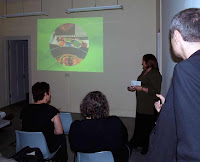Lone Frank claims that neuroscience is the "Fifth Revolution" (I'm a bit unclear on what the other four are, but I'm pretty sure the Copernican Revolution and the Industrial Revolution are among them). In her book,
Mindfield, she quotes the philosopher Daniel Dennett:
"The next generation of geniuses will appear in brain research. Once it was particle physics that attracted the brightest young people, then it was DNA and genome research, but now it is the neurosciences. Because this is where you can answer the big questions."
In the sessions I attended at the recent Sydney Writers' Festival where Lone shared her experience of researching and writing her book, she challenged the audience to consider themselves, in Francis Crick's words, as "a bag of neurons". She predicts that, with increased understanding of the chemical processes in the brain and of how drugs, magnetism and other treatments can control them, there will soon come a day when we think no more of having treatment to boost our brain function than we currently do of cosmetically altering our appearance or self-medicating to change our mood with alcohol.
A number of people in the audience were disturbed by this prediction. The idea of using artificial means to improve brain function seems a little too much like the creation of a superhuman species. Certainly there are some ethical dilemmas that need to be considered: for example, if we develop a drug that can improve memory, should it only be available for those with cognitive impairment, or for everyone who wants to learn more and better? The question also arises about who should be allowed to judge what is normal; and if such a mind-altering drug were to be put onto the market, will economics and pricing mean that the human race is divided into subclasses: the "smart" rich and the "dumb" poor?
Lone, having had experience of clinical depression and salvation from it using anti-depressants, also raised the question of whether happiness is, or should be, a basic human right. Aristotle said that happiness is the ultimate reason for living, and if we can achieve a happier state using drugs that alter our brain chemistry to change our mood, shouldn't we all be taking them all of the time?
These questions, of course, presently operate on almost a purely philosophical level and the issues of side-effects and long-term success of the drugs (most of which are hypothetical at this stage) were not even canvassed during the sessions. It is important, though, for those of us thinking about brain function, that these issues should be flagged now and debate initiated. If we wait until the technology is already in use, when the patents are already in the hands of the big pharmaceutical companies, it will almost be too late to lodge ethical objections. Let's have some discussion on this subject, here on this blog. What do you think?





















